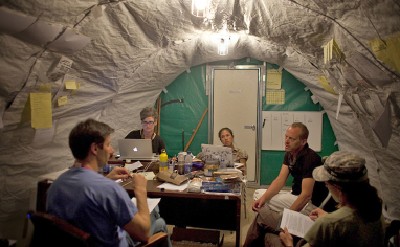BWH Clinicians Vital to Relief Efforts in Haiti

Meeting inside a makeshift office at the field hospital are, from left, Michael VanRooyen and Hilarie Cranmer of BWH, Jennifer Chan and Christian Theodosis of the University of Chicago, and Emille Calvello of Johns Hopkins. Photo by Justin Ide/Harvard University News Office.
After a 7.0-magnitude earthquake struck Haiti Jan. 12, more than 500 clinicians from BWH and MGH signed up as volunteers to fly to the island and assist in relief efforts on the ground.
Selwyn Rogers, MD, MPH, chief of the Division of Trauma, Burn, and Surgical Critical Care, arrived at the Partners In Health hospital in Saint Marc just days after the devastating earthquake and described a dire situation. “We are seeing the natural history of wounds equivalent to the Civil War era when open fractures were not treated surgically,” he wrote in one of several e-mail updates that were published online. “It is horrific.”
BWH was part of a coordinated response with MGH and Partners HealthCare to assist Partners In Health (PIH) by deploying surgeons, nurses, anesthesiologists and other care providers and supplies to the island to aid in relief efforts. BWH also moved quickly with the leadership from the Employee Assistance Program, Chaplaincy, Social Work and Human Resources to support hospital staff who have connections to Haiti. Many other members of the BWH community helped by packing equipment and supplies, including medications, anesthesia machines and epidural and spinal kits, to send to Haiti via PIH.
“The surgical presence that the Harvard hospitals have in the field is extensive,” said Michael VanRooyen, MD, MPH, of BWH Emergency Medicine. He said more than 1,000 surgical cases were still waiting to be seen outside the hospital in Port-au-Prince about two weeks after the earthquake. “Our coordinated response across Partners and PIH is really good, and all of our teams are operational and doing well.”
The Partners and PIH response captured the interest of local and national media, and BWH’s Rogers and Christian Arbelaez, MD, MPH, of Emergency Medicine, provided updates readers of BWHPikeNotes.org, BrighamandWomens.org and Boston.com while on the ground. Arbelaez, who began seeing trauma patients in Saint Marc Feb. 5, reported, “The volume and acuity was high. I saw cases today that I had only read about in books - typhoid fever, leptospirosis, and pulmonary tuberculosis to name a few.”
Hilarie Cranmer, MD, MPH, of Emergency Medicine, arrived in Port-au-Prince just 48 hours after the earthquake, along with Stephanie Rosborough, MD, MPH, of Emergency Medicine, and Jennifer Furin, MD, PhD, of PIH, BWH Infectious Disease and Division of Global Health Equity.
“Words can’t describe the degree to which these people are suffering, and it’s hard to find a place in the city that has been unaffected,” said Cranmer, who was based at the field hospital on UN Headquarters along with Furin and Rosborough. “Logistically, there was huge need for food, water, transportation and security, so we decided we would be most helpful to be in an area that hasn’t received as much attention and wouldn’t require too heavy of logistics.”
Cranmer and Rosborough headed to Fond Parisien in Haiti to set up and lead a field hospital on the Love a Child orphanage compound near the Dominican Republic border. That hospital consisted of rows upon rows of tents housing more than 500 patients receiving surgical and medical care, including measles vaccinations.
Joia Mukherjee, MD, MPH, and David Walton, MD, both of PIH and the Division of Global Health Equity, arrived in the capital city two days after the earthquake to care for patients and pursue a coordinated strategy for medical relief. Teams of physicians and nurses continued to deploy, with BWH anesthesiologists Emily Maher, MD, and Monica Sa Rego, MD, arriving on Jan. 22 in Port-au-Prince to provide anesthesia services with a team of BWHers and others.
“Our major goals continue to be getting the people with the most appropriate specialties out there to support PIH and other teams and to keep them safe,” VanRooyen said.
Support for responding care givers doesn’t stop after they return to Boston. BWH and MGH are reaching out to all physicians and staff and encouraging them to attend de-briefing sessions when they return. The sessions provide guidance and support for staff and also a way for them to provide feedback about the needs of future volunteer teams.
Rogers met with other members of his Haiti team soon after returning. “We really needed to see each other and talk about what we’d been through and seen,” he said, adding that the group frequently e-mails each other and plans to return to Haiti in coming months.
VanRooyen said that BWH will continue to work with PIH about ongoing needs in Haiti, which may focus on wound care and basic health and human services. He plans to collaborate with PIH to replace the volunteers who will be coming home in the next few weeks. “We’ll continue to support PIH as much as possible in coming months.”
Mukherjee, who saw 800 patients on her first day in Haiti, stressed the need for a relief model that also will address the country’s long-term needs. “We expect the needs to escalate—as people live in close quarters, diseases spread,” she said during a conference call for local and national media in February.
That approach must involve supporting the Haitian government’s ability to provide health services and mobilizing grass roots community efforts to participate in health programs. At its core, the Partners In Health model focuses on partnering with communities and hiring health workers from those communities to provide health information, refer people to clinics and report their medical needs to clinic staff.
“A key part of our strategy is to hire more Haitian community health workers, which will allow them to support their families in this desperate situation and strengthen the on-the-ground Haitian response,” Mukherjee said.